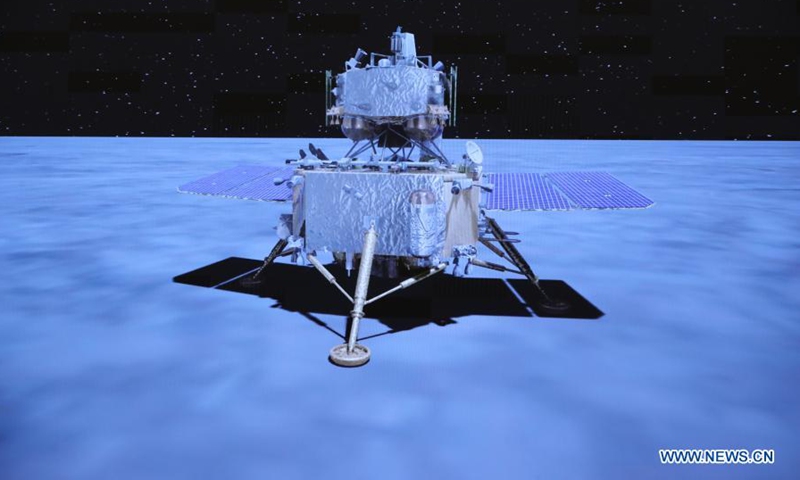
This image taken from video animation at Beijing Aerospace Control Center (BACC) on Dec. 2, 2020 shows Chang'e-5 spacecraft landing on the moon. China's Chang'e-5 spacecraft successfully landed on the near side of the moon late Tuesday and sent back images, the China National Space Administration (CNSA) announced. (Photo: Xinhua)
Counting from the 18th Communist Party of China (CPC) National Congress till September 30, China Academy of Spacecraft Technology (CAST) has developed and successfully launched 262 spacecraft including the Chang'e lunar probes and modules of China Space Station, taking up 65.8 percent of its total output since the establishment of the academy 54 years ago, the Chinese aerospace payload main contractor revealed on Saturday.
Saturday also marked the 19th anniversary that Chinese first taikonaut Yang Liwei rode China's home developed Shenzhou-5 manned spacecraft and successfully visited space for the first time in the country's aerospace history in 2003, and it also came just one day ahead of the opening of the 20th CPC National Congress.
The academy hailed on Saturday that it takes great pride in the glorious achievements in the past decade, listing rapid advancements in space industry China has made in the period including the successful Chang'e lunar probe and Tianwen-1 Mars exploration, the official deployment of BeiDou Navigation Satellite System, and the current building of China Space Station.
China landed the Chang'e-3 probe on the moon surface and carried out roving mission in 2013, which was the first time that the country had executed direct soft landing and probe tasks over an extraterrestrial celestial body. And in 2019, China realized the soft landing on the dark side of moon, a first in human history.
For the first time ever in the country's space history, in 2020, Chang'e-5 brought lunar samples back to Earth. And by achieving that, China completed its three-phase lunar probing plan of "orbiting, landing and returning," with perfect successful rate in all six missions.
Although the global success rate for any lunar probing mission is only 50 percent, China managed to soft land on the near and far side of the moon, and to bring back lunar samples back to Earth all in first attempt, the academy noted on Saturday.
China has also extended its deep space exploration capability from the moon which is 380,000 kilometers away from Earth to 400 million kilometers away to Mars in the past decade. China launched Tianwen-1 Mars probe on July 23, 2020, and after a flight of nine months, its lander touched down on the Red Planet smoothly and released the Zhurong rover, making China the second country worldwide to achieve the feast.
And China is the first in global aerospace history to achieve Mars "orbiting, landing and roving" all in one mission. It signed that China's deep space exploration capability and range have made great leap from exclusively Earth-moon system to an interstellar one.
In December 2012, China's homegrown BeiDou Navigation Satellite System or the BDS started to provide regional service for users. And within three years, the country managed to complete the deployment of BDS-3 satellite constellation. And on July 31, 2020, the BDS-3 was officially commissioned for global service, and China has become the third country to own a global navigation satellite system (GNSS) independently.
The value of China's self-developed BDS exceeded 400 billion yuan ($62.8 billion) by the end of the 13th Five-Year Plan (2016-20) period, the country's top economic planner the National Development and Reform Commission (NDRC) said in April this year.
As of the end of 2021, there have been more than 1 billion terminal devices connected to the BDS positioning service and a total of 324 million domestically made smartphones sold in 2021 applicable to the system, accounting for 94.5 percent of the total shipment of domestic smartphones.
The CAST has also designed and participated in the building process and in-orbit operation of the China Space Station that is currently flying some 400 kilometers above ground and hosting three taikonauts of Shenzhou-14 crew.
Shenzhou-10 manned spacecraft carried out docking and rendezvous with the Tiangong-1 space lab in 2013, which was the first application flight for a Chinese manned spacecraft in history. The Shenzhou-11 manned spaceflight mission with the Tiangong-2 space lab also realized the country's first middle term in-orbit stay of taikonauts.
And in 2017, China's Tianzhou-1 cargo spacecraft was launched and then docked with the Tiangong-2 space lab, demonstrating that the country has mastered all key technology for the building of its own space station.
China's Tianhe space station core module, the first part of the China Space Station was launched April 4, 2021, kick-starting the in-orbit building of the Chinese permanent space home.
The academy has contributed to all eight launches of spacecraft for the building of China Space Station including Shenzhou-12, 13 and 14 manned spacecraft, and Tianzhou-3 and 4 cargo spacecraft and supported two taikonauts return missions and six times of spacewalking missions. The academy has also designed smart robotic arms onboard the space station combination.
In the past decade, China has also completed the building of its high-resolution remote sensing satellite network, performance of which reaches world advanced level. Maritime observation and monitoring satellites Haiyang-1, 2 and Gaofen03 satellites have joined force to strongly support building China into a maritime power nation.
In the domain of space science, China has also developed and launched a microgravity scientific experiment satellite, the country's first seismo-electromagnetic satellite Zhangheng 1 and Tianqin-1, China's first satellite for space-based gravitational wave detection, among others, contributing China's wisdom to the cause.
The academy said it delivered first 100 spacecraft launching using 42 years and the second hundred with only six years, and the third even faster with only over three years. And according plan, it is near its fourth hundred goal within only about two years, reflecting the academy's great leap of core space capabilities in the past decade.
Global Times




